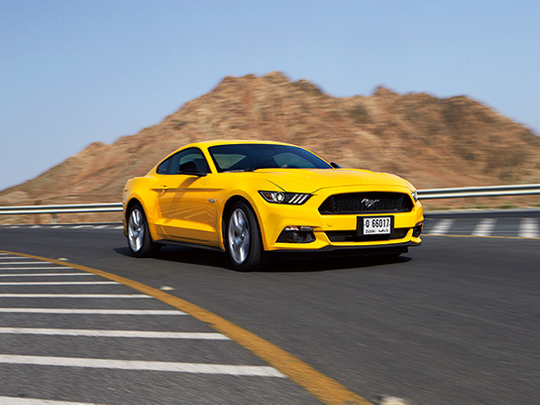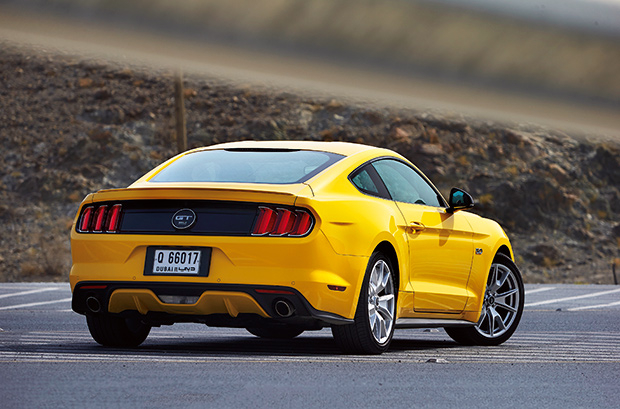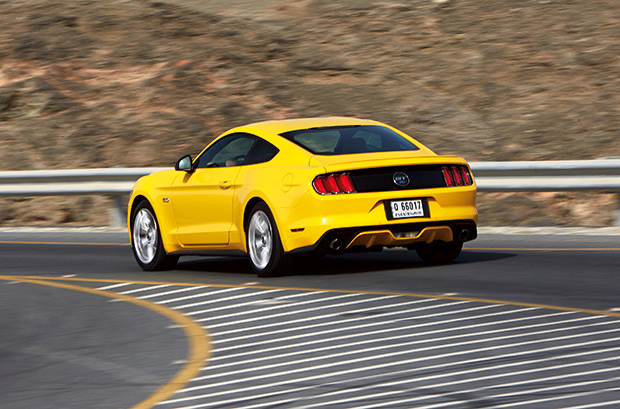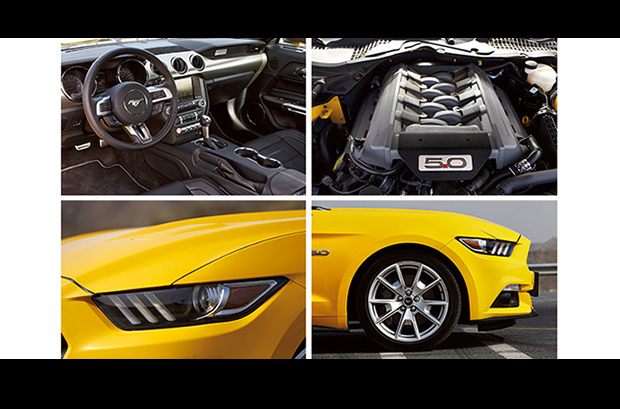
What’s the best Mustang ever? That’s a tough question — there are some real contenders for that title; the 1967 Shelby GT500, 1969 Boss 302, 1971 429 Cobra Jet and countless others. For its sixth generation, Ford has thoroughly updated the Pony by offering a turbo, losing some weight and consigning that live rear-axle to the history books.
The new fully independent set-up may be barely fussed with that Ecoboost motor, but when you spec the five-o, it sure comes in handy as a recent test drive proved. Ford says the dynamics of the Mustang have now been transformed thanks to the “state-of-the-art” shocks and springs. They’re not kidding. This is a car built in Michigan, US, but the Blue Oval is confident it’ll conquer all corners of the world.
A push of a button is all it takes to realise that it has a new lease of life as that massive V8 awakes — but you’d already have guessed as much from the way the Mustang looks now. Although those iconic styling cues such as a long bonnet and stumpy deck are still present, this 2015 Pony pays homage to the original in a thoroughly modern way; it now sits wider and has a roofline that rides considerably lower.
From the trapezoidally shaped grille, bonnet vents and blacked-out rear fascia, the new ’Stang is aggression personified. Those who have been likening it to an Accord Coupé have clearly not seen the all-new Ford in the flesh. The edges may be a tad rounder but there’s no mistaking this for all things a Honda. It retains the three-bulb taillights (still with sequential repeaters) the squinting headlights (now with slanted LED DRLs) and rides on a set of 19in multi-spoke alloys and a loud Triple Yellow Tricoat paint job. It suits the GT’s persona to a T. There’s no denying this is the most menacing Mustang yet.
It’s refined, too, although that might be a bit of a contradiction considering this is a fully fledged muscle car with an extra dollop of muscle (more on that in a bit). The roomy, premium-feel interior features more classic ’Stang touches such as a deeply recessed gauge cluster and a three-spoke multifunction steering wheel (tilt and telescoping for the first time) but the similarities to those of yesteryear end right there.
The gauges may look retro but they’re thoroughly modern; the tachometer — which glows bright red when you’re really stepping on the throttle — has “revolutions per minute” written on it instead of “RPM” and the speedometer says “ground speed”. That’s cool — as is the TFT display nestled between the gauges, which relays all sorts of information including 0-100kph sprint times, as well as meters measuring lateral acceleration and braking distances.
Further investigation around the cabin reveals a far more updated look compared to the previous model. The T-styled dash (designed to make it easier to configure for right-hand drive markets) houses an 8.0in touchscreen with sat-nav, the AC controls (it blows freezing cold) and, most importantly, the Drive mode selector switches, which allow you to tinker with the engine, suspension and steering.
The black leather seats (heated and cooled with power adjustments) are nicely bolstered but you’ll only use the back seat for luggage (fold them forward and you get 382 litres of boot space). The Sync and MyFord Touch still aren’t totally intuitive, however there are no complaints with the booming Shaker audio system, although nothing matches the rumble from the exhaust. It’s been a while since a Mustang got me properly excited.
Powered by a revised 5.0-litre V8, which now includes larger intake and exhaust valves, revised camshafts, new cylinder head castings, redesigned pistons, new forged connecting rods and a rebalanced and forged crankshaft, it produces a whopping 435bhp and 542Nm of torque fed to the rear wheels via a smooth-shifting six-speed automatic.
With the Drive modes in their sportiest settings, the Mustang isn’t just a tyre-shredding muscle car — it’s a full-on sportscar. Acceleration is blindingly fast as is the electric power-assisted steering; you can whip the fat wheel around some challenging corners far quicker than before and because of the new suspension geometry, the GT handles extremely well.
Why did Ford take so long to ditch the leaf springs? Who knows? It doesn’t matter now — this thing finally has a brilliant chassis with extensive use of aluminium making it stiffer, lighter; keeping the ’Stang planted in the corners when you’re gunning it and giving you the confidence to push it even harder.
It feels eager to run and there’s so much power on tap that even traction control is overwhelmed at times as the rear breaks free. Switch it off and floor it and the bright yellow paintwork disappears beneath a plume of white smoke. It can be a comfortable daily driver one minute and a wild beast the next. Yes, so was the previous generation but this one hunts for corners rather than shying away from them and tackles them with gusto and grip that’s never been seen before.
It also now has launch control and my favourite new piece of kit — the Line Lock feature, which holds the front brakes leaving the rear wheels to spin and allows for epically smoky burnouts.
Getting anyone to agree with your choice of favourite Mustang of all time usually results in fists being thrown. It’s a sensitive subject and the process is often long, arduous and downright dangerous. But Ford has now made it easy.
Rather than sift through the many memorable models over the past 50 years (I’d even include the 1978 King Cobra on that list...), all you have to do is forget the past and embrace the present because Ford’s quashed all arguments.
This is the best Mustang ever.















